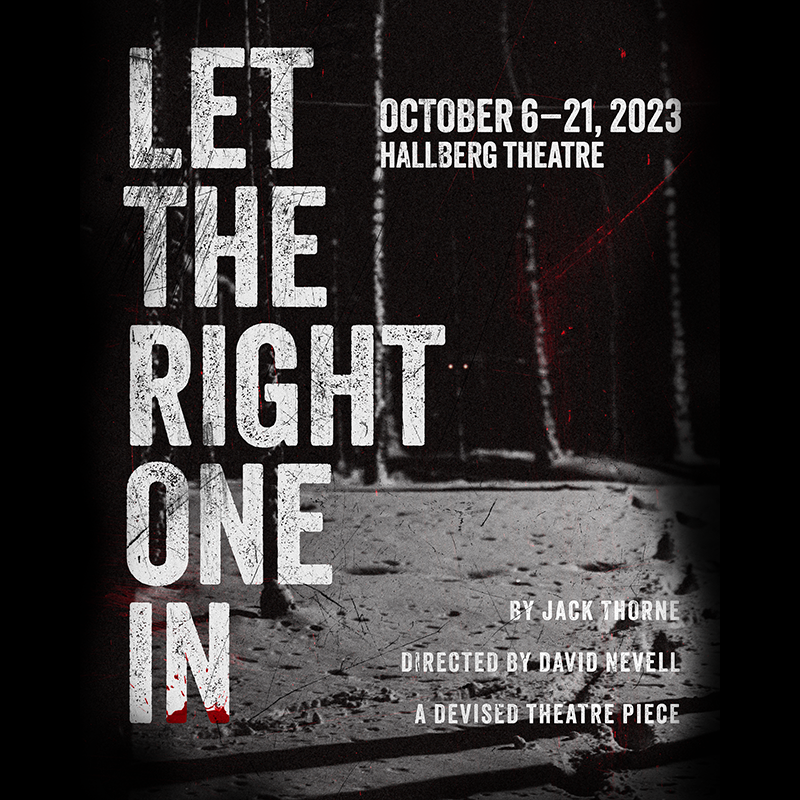By Emma Chavez
This past October, Cal State University Fullerton’s Theatre Department put on a production of “Let the Right One In,” initially written by Jack Thorne and based on the novel by John Ajvide Lindqvist, showcasing their version of the vampire ‘romance’. Since no two productions are the same, it can be exciting to witness how CSUF makes its show stand out from other adaptations. Those who had the privilege of viewing the play were sure to discuss their mixed reviews in the women’s restroom, not shying away from their opinions: some were left confused and bored, while others were still recovering from the play’s climactic ending. Regardless of public opinion, this production of “Let the Right One In” made sure to utilize lighting, projection, and sound design along with the captivating and emotionally moving performances by the two lead actors, to fully immerse and transport the audience into the story, just as if they were a fly on the wall.
This play follows a 12-year-old, troubled boy named Oskar as he navigates his life, having to deal with bullies, divorced parents, an alcoholic mother, and seemingly worst of all, low self-esteem. To add to his luck, a murderer is running loose around his small town, forcing a curfew on all citizens. However, all those issues are brushed aside as he meets a strange and mysterious girl named Eli; she often smells bad, has a disheveled appearance, and is frail and pale-looking. She seems to be very closed off and will not befriend Oskar, but eventually, due to unfortunate life circumstances, the two grow closer, and Eli reveals her secret. Although she may look like a 12-year-old girl, Eli is a 200-year-old vampire who must feed off humans to survive.
This production of “Let the Right One In” was intended to be set in the 1980s, which was made unmistakably clear by using period-accurate costuming and soundtrack throughout the performance. As soon as one enters the black box theatre, a room comprised of four walls that often lacks fixed seating, stage platforms, or scenery, the sound of nostalgic 80’s pop hits can be heard. This music subconsciously sets the mood for audience members and clarifies the period our play is set in. However, these tunes do not stop when the lights go down. Throughout the play, music is often seen as an outlet of emotions for our main character as he is virtually alone without it until he meets Eli. While all alone, he would often be sporting a Walkman and some headphones. A very clever sound technique was utilized during the performance, which included Oskar’s ‘headphone music’ being played throughout the theatre, starting and stopping upon removal. It is almost as If the audience was enjoying the music with him, instead of simply looking in from the outside. Music was not the only stage design element that shined throughout this production. Stage lighting and projections were sure to wow any audience member, as they successfully enhanced the spectacle aspect of the entire production. Adding some spectacle or elaborate visual aspects helps take a production to the next level. It often relies on costumes and scenery to elevate the performance. However, in this case, lighting was utilized to capture the audience. One scene, in particular, made excellent use of lighting and projections to heighten audience members’ emotions during the story’s climax. The scene is set in a school swimming pool as Oskar’s bullies attempt to drown him. Though that may seem challenging to convey on stage, the production uses projection design as they display moving, blue “water projections” all over the theatre. The sounds of moving water can also be heard in sync with cast members hoisting up the main character as if he were treading water in an actual swimming pool. Apart from the actors on stage, the entire theatre is dead silent, helping convey the feeling that the audience is a fly on the wall, unwelcomed but witnessing all, once again, effectively enveloping audiences in this world. As the scene progresses, Eli eventually saves the day by murdering all of Oskar’s bullies. Spotlights are used to highlight the vampire as she appears, while the rest of the theater goes pitch-black, with nothing but the screams of Eli and her victims to be heard. Eli’s actor is seen on a piece of the set as the spotlights quickly flash around the room, and she runs from victim to victim, giving the appearance that Eli is flying over. The entire scene is very visually stimulating, starting from the swimming pool to Eli’s attack, and because the rest of the play is comprised of quieter, more emotion-filled scenes, the last 10 minutes of this production are sure to satisfy audiences with a perfectly horrific fate for our bullies.
While witnessing the lead actors on stage, there is no doubt that they have fully engrossed themselves in their characters. Oskar’s actor presented audiences with a raw and complex performance as his character’s life never seemed to take a good turn. In contrast, Eli’s actor could frighten and captivate audiences as she revealed her darkest secrets. In one specific scene, the kids have grown closer, yet Eli has not revealed her secret. They are hanging around a playground when, eventually, tensions are heightened as Oskar proposes they make a blood pact, slicing his hand in the process. Eli freaks out as she cannot control her hunger around his blood, screaming at Oskar to run. During this scene, Oskar’s actor gives a compelling performance as he stumbles over his words with anxious body language when faced with uncertainty and fear. It is clear how the actor dedicates himself to every movement on stage, with nothing looking planned but nothing looking lost. Once Eli starts to lose control and scream, Oskar’s fear and fondness of Eli can be read from how his actor stumbles and almost cries his way off the stage like he cannot leave Eli there, even though he knows she is dangerous. His feelings of betrayal and hurt are also prevalent in his voice as Eli suddenly turns cold on him, just like everyone in his life. In the same scene, Eli’s actor successfully captures the tone and mood change when Oskar’s blood catches her off guard. The actor makes excellent use of her entire body as Eli is overcome with growing hunger. Her sudden lash-out and roars will fully immerse audiences in the scene as she echoes through the theater. She throws herself on all fours while swarming to Oskar’s blood, panting and seeming desperate for a drop. Her performance shocks Oskar and the audience as her animalistic demeanor gives the impression of being possessed by hunger and her ‘monstrous’ nature. This scene could be recognized as one of the more emotionally intense moments of the play, as any silence on stage is deafening, making every word and action more impactful.
Ultimately, this production of “Let the Right One In” successfully captures the artistry of using projection, lighting, and sound designs paired with powerful performances by lead actors to captivate and transport audiences into Eli and Oskar’s beautifully depressing world.




